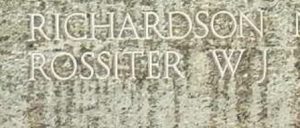St. Florence is a peaceful village, situated three miles inland from Tenby on the road towards Carew Castle. The village is named after Saint Florencius, and has an interesting 13th Century Church, dedicated to him. On the edge of the village are three of Pembrokeshires biggest attractions, Manor House Wildlife Park, Heatherton’s and The Dinosaur Park. The War Memorial is sited within the churchyard, and commemorates the men of the village who died in both world wars. Many thanks to Les Nixon for his photographs of the War Memorial, and of the grave of Frederick Johns, who is buried there.
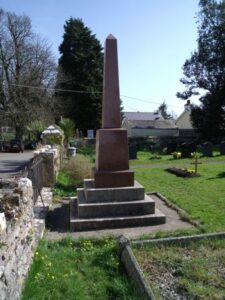
The Great War, 1914-1918
Harold Berkeley Beynon, Private, 33181, Hampshire Regiment. Harold was born in 1897, the son of Thomas Beynon and Laura Annie Beynon (nee Thomas), of Holloway Farm, Penally. He later resided at St. Johns Hill, Tenby, where he worked as a groom prior to enlisting into the Pembrokeshire Yeomanry on 1 April 1914. Following the outbreak of war, Harold was mobilised with the Pembroke Yeomanry, but was soon transferred to the 3rd Battalion, Welsh Regiment. Due to his young age, he remained on home service until being drafted to Salonika on 17 October 1916, joining the 10th Battalion, Hampshire Regiment, which was attached to 82 Brigade, 27th Division. Harold became ill with malaria while in Salonika and returned home for treatment. His service papers show that he was discharged on 17 April 1919 due to ill health following his bout of malaria. His health declined rapidly after being discharged from the army and he died at home of meningitis and encephalitis on 6 May 1919. The 21-year-old was buried in St. Florencius Churchyard, St. Florence. He was originally not commemorated as a war casualty by the CWGC, but following my research, he has recently (January 2012) been accepted for commemoration by the CWGC, who initially added his name to the Brookwood (1914-1918) Memorial, where it remained until the location of his grave was verified. Harold is not commemorated on the St Florence War Memorial, but is commemorated on a plaque within St Florence Church. He is commemorated on war memorials at Penally and Tenby.
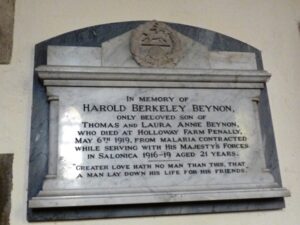
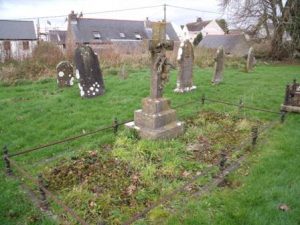
Theophilus John Beynon, Gunner, 27394, Royal Field Artillery. Theophilus was born in London in 1879, the son of John Beynon and Amy Emily Wheeler Beynon (nee Milbourne). His father was from St. Florence and Theophilus spent most of his youth staying there with his grandfather, Evan Beynon following the death of his mother in 1881. Theophilus then lived at Malpas, Monmouthshire for several years until returning to London. He married Gertrude Lizzie Pusey in 1903 and the couple set up home together at 11, Kemble Road, Forest Hill, London, where their three children were born. Theophilus enlisted at London into the Royal Field Artillery soon after the outbreak of war. After completing his training, he was drafted to France on 28 November 1915. The following spring he was posted to the 86th Trench Mortar Battery, which was attached to the newly arrived 29th Division. The division had taken part in the ill-fated Gallipoli campaign, and had refitted in Egypt before moving to the Western Front in March 1916. The division took up positions in the Somme sector, near Beaumont Hamel, and was decimated during the opening phase of the Somme offensive on 1 July that year. The Division was then pulled out of the line to rest and rebuild before moving back into the line and taking part in the latter stages of the Somme offensive. The Division wintered on the Somme, taking part in the advance which followed the German withdrawal to the Hindenburg Line. At the beginning of April, the entire 29th Division moved out of the Somme sector to the Arras sector, and by 9 April took over a section of the line facing Monchy-le-Preux. The Division then began to prepare for the forthcoming Battle of Arras. At dawn on 23 April 1917, the Division launched an assault on Monchy-le-Preux, suffering terrible casualties once again. Theophilus survived the early stages of the Arras offensive, but was killed in action near Loos on 26 May 1917. The 37-year-old was buried in Philosphe British Cemetery, Mazingarbe.
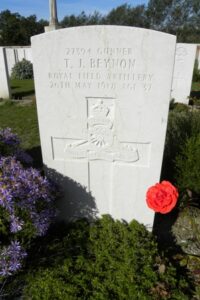
Albert Arthur Hurlow, Private, 68869, Royal Welsh Fusiliers. Albert was born in 1891, the son of John Hurlow and Rhoda Hurlow (nee John), of St. Florence. He had initially enlisted into the Pembroke Yeomanry, but was posted to the Welsh Regiment before being drafted to Salonika in a reinforcement draft to the 11th Battalion, Royal Welsh Fusiliers, which was attached to 67 Brigade, 22nd Division. The division had crossed to France in early September 1915, with all units being concentrated near Flesselles by the 9th of the month, however it’s stay in France was to be very short, as on 27 October 1915 the Division, having been moved by train to Marseilles, began to embark for Salonika. It completed concentration there in November, as part of a large force being assembled by the French and British to aid the Greek army following the invasion of neighbouring Serbia by a combined Austrian and Bulgarian army. Over the coming months several large-scale battles were fought by the Allies, but the front remained largely at stalemate for much of the war. Albert was killed in Salonika on 19 February 1917. The 24-year-old was buried in Karasouli Military Cemetery, Greece.
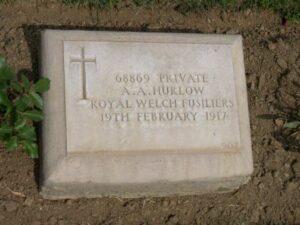
David James, Petty Officer, 183045, Royal Navy. David was born on 25 October 1878, the son of Hannah James, of St. Florence. David had worked as a labourer prior to enlisting into the Royal Navy on 25 October 1896 and was posted to HMS Impregnable for training. Over the coming years he served aboard a number of ships, including HMS Ganges, HMS Warspite, HMS Calypso and HMS Andromeda, passing out as a Petty Officer by March 1909. By the spring of 1911 David was serving aboard HMS Monmouth, which was stationed in China and by the time the Great War erupted, he had been posted aboard the River Class destroyer, HMS Kennet, which was stationed with a British squadron at Tsingtau, China. On the night of 22 August 1914, just after the Japanese declaration of war, the British squadron began to withdraw to avoid any possible accidental clash with the Japanese. Soon afterwards, HMS Kennet spotted the German destroyer S.90 which was heading into Tsingtao from the east. Kennet attempted to catch the S.90, but came under heavy fire, suffering the loss of three men killed when one of its guns was hit and put out of action. David was one of these three men killed that day aboard Kennet. The 35-year-old was buried at sea, so is commemorated on the Plymouth Naval Memorial, Devon.
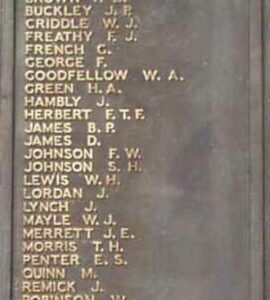
Griffith Hugh Davies John, Gunner, 3123, Australian Field Artillery. Griffith, known as Hugh, was born at Cresselly on 19 July 1892, the son of William Davies John and Sarah Catherine John (nee Davies). He was raised by his grandfather, Thomas John, JP, at Elm Grove, St. Florence, following the death of his father in 1893. Hugh had emigrated to Australia aboard the SS Omrah in 1909 and gained work there as a farmer. By the summer of 1915 the Australian Imperial Force was making a name for itself during the fighting at Gallipoli. Many young Australians flocked to join the AIF, to take part in this great adventure that the propaganda had promised them, and so on 25 June 1915 Hugh enlisted at Blackboy Hill into the Australian Infantry, after being turned down from the Light Horse. After training, Hugh was posted to the 10th Reinforcements for the 16th Battalion, AIF, and embarked at Fremantle aboard HMT Themistocles on 13 October 1915 bound for Egypt. Early in 1916 the Australian battalions that had fought on Gallipoli were divided up to double the size of the AIF, with half the men going to the new battalions, and the positions being taken up by reinforcements. As a result, Hugh was posted to the 48th Battalion, AIF. His service papers then show a long history of illness, with several spells in hospitals in England over the coming months. In June 1917 he was posted to the 7th Field Artillery Battery, Australian Field Artillery, and in August was shot in the buttocks while fighting at Ypres. Again Hugh was hospitalised, and it was not until February 1918 that he was back in France, but he was soon in hospital ill again. Yet again Hugh returned to action, but was wounded for a second time during October 1918, during the fighting around the Hindenburg Line, and returned home for treatment at the Red Cross Hospital, Sittingbourne. Unfortunately Hugh took ill whilst in hospital and died of pneumonia there on 30 October 1918. The remains of the 26-year-old were conveyed back to Pembrokeshire and he was buried in St. Womar’s Churchyard, Minwear on 5 November.
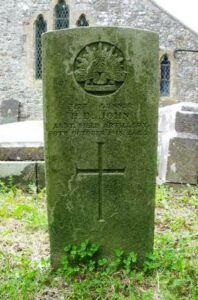
Thomas James Owen, Leading Stoker, 310044, Royal Navy. Thomas was born at Kenfig Hill on 1 March 1888, the son of William Llewellyn Pridy Owen and Emma Owen (nee Fabian). Soon afterwards the family moved to Copy Bush Farm, St. Florence. Thomas worked as a farm labourer prior to enlisting into the Royal Navy on 20 April 1906 and was posted to HMS Vivid II for training. Over the coming years he had postings aboard several different ships, including HMS Indus, HMS Skirmisher, HMS Majestic and HMS New Zealand, before being posted aboard the battlecruiser HMS Invincible on 21 June 1913. Invincible was the first battlecruiser to have ever been built. She took part in the Battle of Heligoland Bight early in the war, then in the Battle of the Falkland Islands, when Invincible and her sister Inflexible sank the armoured cruisers Scharnhorst and Gneisenau. She was the flagship of the 3rd Battlecruiser Squadron during the Battle of Jutland. The squadron had been detached from Admiral Beatty’s Battlecruiser Fleet a few days before the battle for gunnery practice with the Grand Fleet and acted as its heavy scouting force during the battle. Invincible was destroyed by a magazine explosion during the battle, on 31 May 1916, after her ‘Q’ turret was penetrated by a large calibre German shell, exploding and going down with the loss of over 1,026 men. Thomas was 27 years old when he was killed during the loss of Invincible. He has no known grave, so is commemorated alongside his shipmates on the Plymouth Naval Memorial, Devon.
William James Rossiter, Gunner, 302024, Royal Garrison Artillery. William was born on 20 August 1894, the son of Emma Rossiter, of Fern Cottage, St. Florence. William worked as a collier prior to the war and lodged at 1, Fernhill, Treherbert. He enlisted into the Royal Garrison Artillery, and was posted to the 10th Highland Mountain Brigade, which was in Palestine. William fought throughout much of the Palestinian Campaign, along with many other Pembrokeshire men, but unfortunately contracted malaria. He died of malignant malaria on 25 October 1918. The 24-year-old is buried in Haifa War Cemetery, Israel.
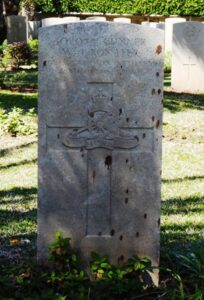
John Isaac Thomas, Private, 34215, Loyal North Lancashire Regiment. John was born in 1879, the son of Mary Thomas, of St. Florence. He was living at New Malden, Surrey by 1899, where he worked as a gardener. John married Agnes Sarah Gadd, a domestic servant, at New Malden Parish Church on 2 December 1899. By 1911 the family had moved to Wooton-Under-Edge, Gloucestershire, and had eight children. John enlisted at Dursley into the Gloucestershire Regiment, but was later transferred into the 1st Battalion, Loyal North Lancashire Regiment, which was part of 2 Brigade, 1st Division. The Division had been one of the first to arrive in France, fighting at the Battle of Mons, and taking part in the retreat to the Marne, where the Germans were stopped. They then fought at the Aisne, and at Chivy, before being moved North to Ypres. Here they fought at the First Battle of Ypres, where they again stopped the German Offensive, before wintering in Flanders. The following year saw them in action again at the Battle of Aubers, before moving South to Loos, where they fought during the Battle of Loos, and the action at the Hohenzollern redoubt. Again they were required for a major offensive, moving South to the Somme, where they fought during the opening of the Somme Offensive at the Battle of Albert, then at Bazentin, Pozieres, Flers-Courcelette and Morval. They followed the German retreat to the Hindenburg Line in early 1917, and were then briefed for an operation on the Flanders Coast, and moved there during the summer of 1917. While training on the coast, the Battle of Third Ypres had stalled in the mire, and the Division were recalled to Ypres, where they fought at the Second Battle of Passchendaele. John was killed here on 10 July 1917, aged 38. His is one of the few named graves in Sanctuary Wood Cemetery, on Hill 62, Belgium.
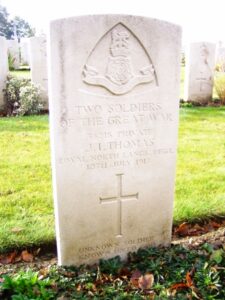
World War Two, 1939-1945
Francis Alfred Hinley, Gunner, 843617, Royal Artillery. Francis was born on 3 June 1916, the son of Francis Edgar Hinley and Florence Ada Hinley (nee Bartlett), of Greenwich, London. He married Vera Jones, of St. Florence, in 1937. Francis served with 9 Coast Regiment, Royal Artillery. The regiment was based in Singapore when the garrison was attacked by the Japanese in December 1941. After the surrender of the garrison, Francis was taken into captivity and held at Changi Jail. He was transported to Japan aboard one of the infamous Hell-Ships, and died in captivity at Tokyo POW Camp on 18 March 1945, aged 31. Francis is buried at Yokohama War Cemetery, Japan. Vera never remarried, and died in Pembrokeshire in 1994. Francis is not commemorated at St. Florence.
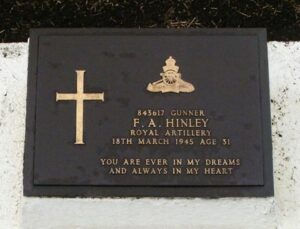
Frederick Thomas Johns, Corporal, 4197621, Royal Welch Fusiliers. Frederick was born on 1 June 1919, the son of Thomas Johns and Amelia Ellen Johns (nee Walker), of 3, Rock Terrace, St. Florence. He worked as an antique furniture restorer and cabinet maker prior to the war. Frederick enlisted into the army soon after the outbreak of war and was posted to the 7th Battalion, Royal Welch Fusiliers, a Territorial Army battalion, which was attached to 158th Infantry Brigade, 53rd (Welsh) Division. The battalion was mobilised at the outbreak of war, when the Division moved to Northern Ireland to begin garrison duties. The Division then moved to Pembroke Dock, before moving again to the south of England, where it trained in readiness for the D-Day Landings. The division was on garrison duties in Kent when Frederick died at Canterbury on 19 August 1942. The remains of the 23-year-old were conveyed back to Pembrokeshire and he was buried in St. Florence, at St. Florencius Churchyard on 22 August.
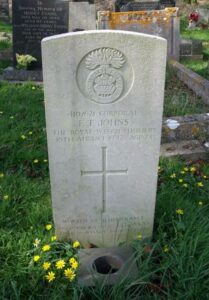
George Frederick Methuen Roblin, Stoker 2nd Class, D/KX 135253, Royal Navy. George was born on 10 May 1923, the son of Richard Roblin and Alice Maud Roblin (nee Stephens), of Rising Sun, St. Florence. He enlisted into the Royal Navy and was posted aboard the Tribal-class destroyer HMS Matabele. The ship had been commissioned in January 1939 and following the outbreak of war was used in patrol work, looking out for German shipping and U-Boats. In January 1942 she formed the screen, along with with HMS Somali, for the cruiser HMS Trinidad on Convoy PQ-8 from Iceland to Murmansk. The convoy departed on 11 January, and came under torpedo attack on 16 January. On 17 January Matabele was hit by a torpedo from U-454 and sank almost immediately. Only two out her complement of 238 survived. Many who were able to leave the stricken ship succumbed in the ice-cold water before rescue was possible. The two survivors were picked up by the minesweeper HMS Harrier. George was among the men lost that day. He was just 18 years old, and is commemorated on the Plymouth Naval Memorial, England.
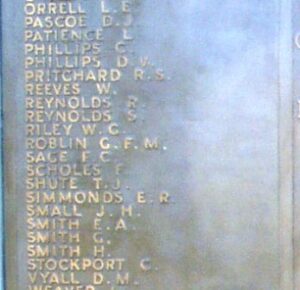
William John Rossiter, Gunner, 1426078, Royal Artillery. William was born on 30 August 1903, the son of William Rossiter and Rose Rossiter (nee Roberts), of Sheep Walks, St. Florence. He enlisted into the army and was posted to the Royal Artillery, joining the 68th Medium Regiment, Royal Artillery upon completing his training. The Regiment was sent to High Wycombe after the retreat from Dunkirk, before embarking for Eritrea in September 1940. Very little is presently known of William’s service, but he was posted to Crete, where he killed during the German Airborne invasion of the Island on 28 May 1941. William was 37 years old, and is commemorated on the Athens Memorial, Greece. His father William had been killed during WW1.
